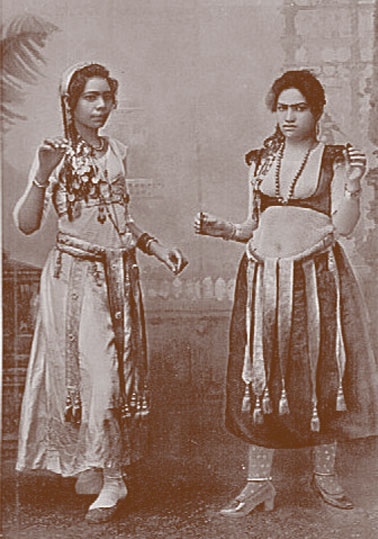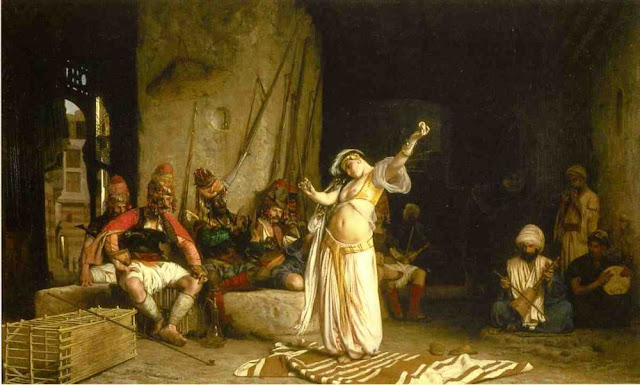Ghawazee
The Ghawazi (also ghawazee) dancers of Egypt were a group of female traveling dancers of the Dom people (also known as Nawar).
The ghawazi style gave rise to the Egyptian raqs sharqi by the first half of the 20th century, and in turn to the Western forms of belly dance.
While the performative raqs sharqi in urban Egypt was heavily influenced by Western styles such as classical ballet or Latin American dance, the term ghawazi in Egypt refers to the dancers in rural Egypt who have preserved the traditional 18th to 19th century style.
The Ghawazi performed unveiled in the streets. Rapid hip movement and use of brass hand castanets characterized their dance. Musicians of their tribe usually accompanied them in their dance. They usually wore kohl around their eyes and henna on their fingers, palms, toes and feet.
The Ghawazi performed in the court of a house, or in the street, before the door, on certain occasions of festivity in the harem. They were never admitted into a respectable harem, but were frequently hired to entertain a party of men in the house of some rake. Both women and men enjoyed their entertainment. However, many people who were more religious, or of the higher classes, disapproved of them.
Massin sisters, Luxor, Egypt
Video: Banat Mazin (1967)
These are the three elder Mazin sisters, Souad, Tukha & Ferial, members of one of the last actively performing Ghawazee families. This clip is from the 1967 film 'Al Zawja al Thania' (The Second Wife الزوجة الثانية ). The film tells the story of a nasty village mayor (Salah Mansour) who tires of his first wife and forces Abdulla (Shukry Sarhan) who is one of the villagers to divorce his own wife, Fatima,(Suad Hosni) so the mayor can marry her and bear a male heir. Turns out that Fatima is already pregnant by her husband so the headman has a fit and is paralysed and Fatima restores everything to the way it should be.
Geschichte der Ghawazee
Die Herkunft dieser Ghawazee ("Eroberer der Herzen"; die Einzahl lautet ghaziya) ist unsicher. Die meisten von ihnen ordnen sich dem Stamm der Nawar zu und sprechen in der Tat eine nicht-arabische Sprache. Auch ihre Gesichtszüge verraten eine andere Herkunft. Die Nawar sollen ein Roma-Stamm sein, der Afghanistan und die Türkei durchwandert hat, ehe er in Ägypten ankam. Allerdings besetzte die Türkei seit dem 16. Jahrhundert Ägypten, und es ist auch möglich, dass diese Frauen aus der Türkei gekommen sind.
Die Ghawazee wurden zu allen Arten von Festen (Hochzeiten, Beschneidungen usw.) eingeladen und tanzten manchmal im Haus, manchmal vor dem Tor. In den auf ihre Ehre bedachten Harems waren sie nicht willkommen. Sie tanzten auch vor Ausländern, die ihre Künste mit viel Geld entlohnten. Manchmal erhielten sie ausnahmsweise die Erlaubnis, in einem Haremshof unter den Fenstern der Frauen aufzutreten. Auch beim Tanz auf der Straße plazierten sie sich oft unter den Gitterfenstern, damit die Haremsfrauen sie durch ihre Gucklöcher beobachten konnten.
Ägypten ca. 1920






Keine Kommentare:
Kommentar veröffentlichen
Hinweis: Nur ein Mitglied dieses Blogs kann Kommentare posten.